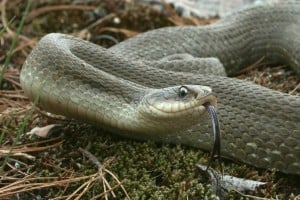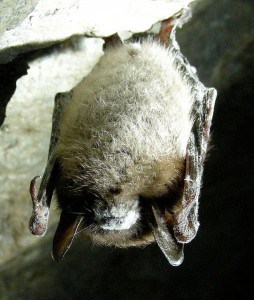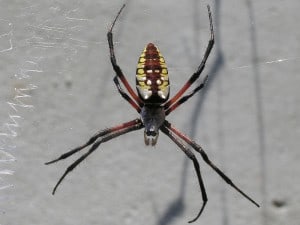For some people, the natural world can be an intimidating place. Although it might seem illogical to be afraid of a tiny creature like a spider or bat, we can’t deny that some animals do indeed elicit a fear response. With Halloween upon us, what better time to talk about fear of the natural world, be it anxiety at the sound of thunder or revulsion at the sight of a spider running across the bathroom floor.
An aversion to particular animals was almost certainly critical to the survival of early humans. As much as being too fearful would have made survival difficult, insufficient fear would have led to reckless behaviour and possibly death. In the 21st century, however, you can still have these feelings of angst and at the same time experience a deep appreciation and respect for the animal in question. Stephen Kellert, author of “Birthright: People and Nature in the Modern World” says that: “While aversive emotions towards (certain) animals are typically strong, they can also be positively channeled into fascination, curiosity and exploration.” For example, a fear of snakes or wolves doesn’t have to provoke destructive behaviours.
When I was teaching, I always made of point of encouraging my students to hold or touch the many animals that visited our classroom or that we encountered outside. However, there was always the odd student who would refuse to do so. I would sometimes be a little facetious and say something like: “Did you have a bad experience with a snake once and get bitten?” Never was this the case. So, where do fears like this come from and what are we to make of them?
Snakes – Approximately one adult human in three suffers to some degree from ophiophobia, a fear of snakes. Some people are afraid of even thinking of snakes or looking at images of them. This fear may be an inherent reaction, however, and we aren’t alone in this regard. An innate fear of snakes is present even in our closely-related primate cousins, the monkeys. In one famous experiment, monkeys literally panicked when suddenly exposed to snakes, even though they had been raised in a laboratory and had never seen these reptiles before.
Snakes and early primates may have been involved in an evolutionary “arms race” of sorts. According to Lynne Isbell, an anthropologist at the University of California, the survival of early primates depended to a large extent on ways to detect and avoid snakes. Fossil and DNA evidence suggests that the snakes were already around when the first primates were evolving some 60 million years ago and were among the first serious predators our ancestors faced. Early primates were adapted to living in trees, searching for food at night and sleeping in the canopy during the day. Snakes slithering through those trees would have been a constant threat. This may explain the evolution in primates of adaptations such as a better eye for colour, detail and movement. All of these abilities would have been very important for detecting threats at close range. To keep up with primate evolution, snakes had to get better at killing their prey. This may have driven the evolution of venom, according to Isbell.
Bats – A fear of bats may simply be related to the natural startle response experienced by an unsuspecting person when a bat somehow finds itself into a house and flies about erratically looking for a quick exit. Tied to this are vague notions of these flying mammals getting caught in your hair (never happens) or that most bats have rabies, which isn’t true either. Even among sick bats submitted for rabies testing, only a tiny percentage ever test positive, and those that do are usually clumsy, disoriented, and unable to fly. We should also remember that you can only get rabies if a rabid animal bites you. Contrary to a widespread misconception, only three species of bats feed on blood – mostly livestock – and these species all live in Latin America. In fact, the majority of bats are terrified of humans and see man as a potential predator.
If anything, we should be afraid FOR bats, not of them. White-nose syndrome (WNS) named for a distinctive fungal growth around the muzzles and on the wings of hibernating bats, has resulted in the deaths of at least 6 million North American bats. In fact, the once-abundant Little Brown Bat is expected to go extinct in the wild. In Ontario, it is now on the list of endangered species. In the seven years since WNS first showed up, Ontario’s bat population is estimated to have dropped by over 90 per cent. This is an extinction tragedy of unprecedented proportions. You don’t have to find bats warm and cuddly to feel great sadness in the crisis they are now facing. Their disappearance is making the natural world a lonelier and less fascinating place.
Wolves – When it comes to the complicated relationship between fear and fascination for a wild animal, there are few better examples than the wolf. Wolves used to be universally reviled and many people wanted to annihilate them altogether. Yes, they may have represented a real danger to our distant ancestors. In modern times, however, wolf persecution is more closely linked to reasons such as livestock depredation. Thankfully, attitudes towards wolves have now shifted dramatically. Much of this has to do with a growing understanding of wolf biology and the huge ecological value of these animals. When wolves are behind bars in a zoo or wildlife park, however, and any element of danger has disappeared, the sense of wonder they inspire falls precipitously. That is why having healthy populations of wild wolves is so important.
Invertebrates – Bugs – to use the vernacular – seem to attract an especially widespread aversion. It’s true that a healthy respect for wasps, leeches, spiders and similar creatures is a useful trait, since it helps us to avoid pain and disease. There are certainly deeper psychological reasons, too, for a dislike of “creepy crawlies.” Their lack of feeling and reason is a probably a big part of it. As Kellert writes: “All they seem to have in common with us are vaguely familiar body parts and a passion to survive and reproduce.” Despite this innate dislike on the part of many people, it’s still possible to learn to respond to these creatures with curiosity and a sense of wonder. There is still so much we don’t know about the invertebrate world. An entire scientific career awaits curious, young researchers.
So, what should we be afraid of in 2014? I would argue that climate change should be near the top of any list. It’s clear that living in a highly technological society where so much of nature has been subdued has greatly reduced our fear of extreme weather. This may partly explain why we continue to engage in the dangerous behaviour of pouring ever-greater amounts of greenhouse gases into the atmosphere. This is why I was so discouraged last week by the cries of joy when the cost of gasoline plummeted. Why aren’t more people joining the dots linking low fuel prices, increased consumption, increased greenhouse gas emissions and accelerated disruption of the climate? Evolution, however, never prepared us for slow-motion threats like climate change. We’re much better at reacting to something like the Ebola outbreak where the impact is immediate and dramatic.


